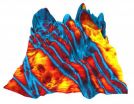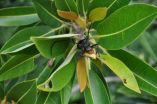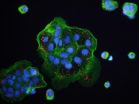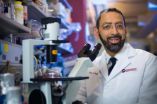(Press-News.org) At the heart of computing are tiny crystals that transmit and store digital information's ones and zeroes. Today these are hard and brittle materials. But cheap, flexible, nontoxic organic molecules may play a role in the future of hardware.
A team led by the University of Washington in Seattle and the Southeast University in China discovered a molecule that shows promise as an organic alternative to today's silicon-based semiconductors. The findings, published this week in the journal Science, display properties that make it well suited to a wide range of applications in memory, sensing and low-cost energy storage.
"This molecule is quite remarkable, with some of the key properties that are comparable with the most popular inorganic crystals," said co-corresponding author Jiangyu Li, a UW associate professor of mechanical engineering.
The new carbon-based material could offer even cheaper ways to store digital information; provide a flexible, nontoxic material for medical sensors that would be implanted in the body; and create a cheaper, lighter material to harvest energy from natural vibrations.
The new molecule is a ferroelectric, meaning it is positively charged on one side and negatively charged on the other, where the direction can be flipped by applying an electrical field. Synthetic ferroelectrics are now used in some displays, sensors and memory chips.
In the study the authors pitted their new molecule against barium titanate, a long-known ferroelectric material that is a standard for performance. Barium titanate is a ceramic crystal and contains titanium; it has largely been replaced in industrial applications by better-performing but lead-containing alternatives.
The new molecule holds its own against the standard-bearer. It has a natural polarization, a measure of how strongly the molecules align to store information, of 23, compared to 26 for barium titanate. To Li's knowledge this is the best organic ferroelectric discovered to date.
A recent study in Nature announced an organic ferroelectric that works at room temperature. By contrast, this molecule retains its properties up to 153 degrees Celsius (307 degrees F), even higher than for barium titanate.
The new molecule also offers a full bag of electric tricks. Its dielectric constant – a measure of how well it can store energy – is more than 10 times higher than for other organic ferroelectrics. And it's also a good piezoelectric, meaning it's efficient at converting movement into electricity, which is useful in sensors.
The new molecule is made from bromine, a natural element isolated from sea salt, mixed with carbon, hydrogen and nitrogen (its full name is diisopropylammonium bromide). Researchers dissolved the elements in water and evaporated the liquid to grow the crystal. Because the molecule contains carbon, it is organic, and pivoting chemical bonds allow it to flex.
The molecule would not replace current inorganic materials, Li said, but it could be used in applications where cost, ease of manufacturing, weight, flexibility and toxicity are important.
Li is working on a number of projects relating to ferroelectricity. Last year he and his graduate student found the first evidence for ferroelectricity in soft animal tissue. He was co-author on a 2011 paper in Science that documents nanometer-scale switching in ferroelectric films, showing how such molecules could be used to store digital information.
"Ferroelectrics are pretty remarkable materials," Li said. "It allows you to manipulate mechanical energy, electrical energy, optics and electromagnetics, all in a single package."
He is working to further characterize this new molecule and explore its combined electric and mechanical properties. He also plans to continue the search for more organic ferroelectrics.
INFORMATION:
The joint first authors of the new paper are Yuanming Liu, a UW postdoctoral researcher in mechanical engineering, and Da-Wei Fu, a doctoral student working with co-corresponding author Ren-Gen Xiong at Southeast University. Other co-authors are Hong-Ling Cai, Qiong Ye, Wen Zhang and Yi Zhang at Southeast University; Xue-Yuan Chen at the Chinese Academy of Sciences; and Gianluca Giovannetti and Massimo Capone at the Italian National Simulation Centre.
The research was funded by the U.S. National Science Foundation, China's National Natural Science Foundation and the European Research Council.
For more information, contact Li at 206-543-6226 or jjli@uw.edu.
Organic ferroelectric molecule shows promise for memory chips, sensors
2013-01-25
ELSE PRESS RELEASES FROM THIS DATE:
HIV-like viruses in non-human primates have existed much longer than previously thought
2013-01-25
Viruses similar to those that cause AIDS in humans were present in non-human primates in Africa at least 5 million years ago and perhaps up to 12 million years ago, according to study published January 24 in the Open Access journal PLOS Pathogens by scientists at Fred Hutchinson Cancer Research Center. Until now, researchers have hypothesized that such viruses originated much more recently.
HIV-1, the virus responsible for AIDS, infiltrated the human population in the early 20th century following multiple transmissions of a similar chimpanzee virus known as SIVcpz. Previous ...
Bats split on family living
2013-01-25
For the tiny Daubenton's bat, the attractions of family life seem to vary more with altitude than with the allure of the opposite sex.
For more than a decade, a team led by Professor John Altringham from the University of Leeds' School of Biology has studied a population of several hundred bats along a 50-km stretch of the River Wharfe. They monitored roosts in Ilkley and Addingham, upstream in the market town of Grassington and higher still in the villages of Kettlewell and Buckden.
The researchers found that all Daubenton's bats in nursery roosts in lowland areas ...
Extinction rates not as bad as feared ... for now
2013-01-25
Concerns that many animals are becoming extinct, before scientists even have time to identify them, are greatly overstated according Griffith University researcher, Professor Nigel Stork.
Professor Stork has taken part in an international study, the findings of which have been detailed in "Can we name Earth's species before they go extinct?" published in the journal Science.
Deputy Head of the Griffith School of Environment, Professor Stork said a number of misconceptions have fuelled these fears, and there is no evidence that extinction rates are as high as some have ...
Organizing human specimen collections: Getting the best out of biobanks
2013-01-25
The diversity of biobanks, collections of human specimens from a variety of sources, raises questions about the best way to manage and govern them, finds a study published in BioMed Central's open access journal Genome Medicine. The research highlights difficulties in standardizing these collections and how to make these samples available for research.
Biobanks have been around for decades, storing hundreds of millions of human specimens. But there has been a dramatic increase in the number of biobanks in the last ten years, since the human genome sequencing project. ...
Immune cell suicide alarm helps destroy escaping bacteria
2013-01-25
CHAPEL HILL, N.C. – Cells in the immune system called macrophages normally engulf and kill intruding bacteria, holding them inside a membrane-bound bag called a vacuole, where they kill and digest them.
Some bacteria thwart this effort by ripping the bag open and then escaping into the macrophage's nutrient-rich cytosol compartment, where they divide and could eventually go on to invade other cells.
But research from the University of North Carolina School of Medicine shows that macrophages have a suicide alarm system, a signaling pathway to detect this escape into ...
Out-of-pocket costs for breast cancer probably manageable for most Canadian women
2013-01-25
Out-of-pocket costs resulting from breast cancer care in the year following diagnosis are likely manageable for most women, but some women are at a higher risk of experiencing the financial burden that comes from those costs in Canadian breast cancer patients, according to a study published January 24 in the Journal of the National Cancer Institute.
While extensive information about the level of out-of-pocket costs after early breast cancer diagnosis has been unavailable until now, the costs resulting from the disease and the effects the costs have on family financial ...
Fruit and vegetable intake is associated with lower risk of ER- breast cancer
2013-01-25
There is no association between total fruit and vegetable intake and risk of overall breast cancer, but vegetable consumption is associated with a lower risk of estrogen receptor-negative (ER-) breast cancer, according to a study published January 24 in the Journal of the National Cancer Institute.
The intake of fruits and vegetables has been hypothesized to lower breast cancer risk, however the existing evidence is inconclusive. There are many subtypes of breast cancer including ER- and ER positive (ER+) tumors and each may have distinct etiologies. Since ER- tumors, ...
Spotting fetal growth problems early could cut UK stillbirths by 600 a year
2013-01-25
The authors say spotting it early could substantially reduce the risk, and this needs to become a cornerstone of safety and effectiveness in antenatal care.
Stillbirth rates in the United Kingdom are among the highest in developed countries. They have often been considered unexplained and unavoidable, and their rates have changed little over the last two decades.
Recently, doctors have found that many stillborn babies fail to reach their growth potential, prompting a renewed focus on what causes fetal growth restriction. So a team of researchers at the West Midlands ...
Scientists discover how epigenetic information could be inherited
2013-01-25
New research reveals a potential way for how parents' experiences could be passed to their offspring's genes. The research was published today, 25 January, in the journal Science.
Epigenetics is a system that turns our genes on and off. The process works by chemical tags, known as epigenetic marks, attaching to DNA and telling a cell to either use or ignore a particular gene.
The most common epigenetic mark is a methyl group. When these groups fasten to DNA through a process called methylation they block the attachment of proteins which normally turn the genes on. ...
Researchers discover new mutations driving malignant melanoma
2013-01-25
BOSTON—Two new mutations that collectively occur in 71 percent of malignant melanoma tumors have been discovered in what scientists call the "dark matter" of the cancer genome, where cancer-related mutations haven't been previously found.
Reporting their findings in the Jan. 24 issue of Science Express, the researchers from Dana-Farber Cancer Institute and the Broad Institute said the highly "recurrent" mutations – occurring in the tumors of many people – may be the most common mutations in melanoma cells found to date.
The researchers said these cancer-associated ...



